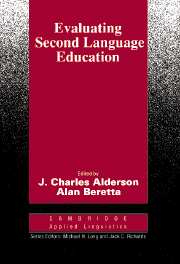III - GUIDELINES FOR THE EVALUATION OF LANGUAGE EDUCATION
Published online by Cambridge University Press: 05 October 2012
Summary
The aim of this final chapter is to bring together the various threads running through the book on what might be or are more and less appropriate ways to conduct evaluations of language education. In addition, it is hoped that it will provide would-be evaluators with guidance on how to go about designing and implementing an evaluation (the sort of guidance that Palmer – this volume – wishes had been available to him). The chapter aims to suggest answers to the perennial WH questions in evaluation: who, what, when, how, how long, to evaluate and to point the way forward to further developments (and hopefully improvements) in the methodology and practice of language education evaluation.
The organisation of the chapter follows the usual and logical stages in the conduct of an evaluation: planning, implementing, interpreting, reporting, using, evaluating. Inevitably, the first section, on the planning of an evaluation, is the longest, since this is the most important stage: it is difficult to adjust later for mistakes or omissions at this stage. However, as this chapter is intended to provide practical guidance, to relate to the real, imperfect and under-resourced world in which evaluations are usually conducted, it will be recognised that perfect planning and design are both rare and unlikely, and therefore attention will also be paid to how imperfections in design can be catered for at later stages.
The reader should, however, beware of concluding from this chapter that there is One Best Way of conducting an evaluation. There is not.
- Type
- Chapter
- Information
- Evaluating Second Language Education , pp. 274 - 304Publisher: Cambridge University PressPrint publication year: 1992
- 10
- Cited by



